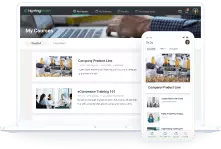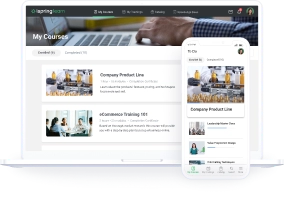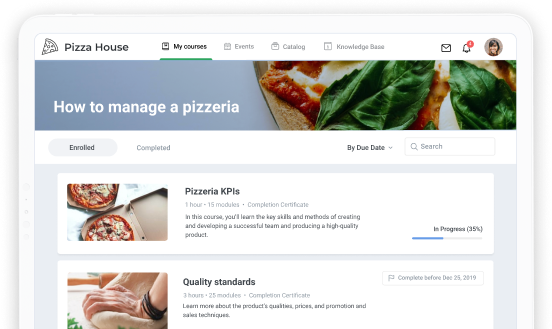VILT Software: The 10 Best Virtual Training Platforms for Effective Learning

It’s no secret that the popularity of virtual training is on the rise. It is a cost-effective and environmentally friendly way to educate employees and students. As such, organizations need specific software for providing training sessions online. But before we look at the 10 best virtual training platforms for 2023, let’s first see what a VILT platform is and what to consider when selecting an option.
How to Choose a Virtual Training Platform
A virtual training platform is software that’s used to host virtual instructor-led training (VILT). It effectively recreates the traditional classroom training experience in a virtual setting, using engagement tools to encourage trainee participation. There is a plethora of VILT solutions on the market. Therefore, it’s important to do some ‘homework’ when it comes to choosing the right option for your business.
We recommend focusing your attention on virtual instructor-led training platforms that provide two training modes: video conferencing and self-paced learning. That way, your company has more flexible training options to better suit ever-changing employee and business needs.
Opting for a virtual instructor-led training software with LMS capabilities will allow you to create, deliver, and track all kinds of training in one place. This means you can conduct VILT sessions, assign online courses to supplement virtual training, and track attendance and results all on one platform. What’s more, L&D and HR teams can manage all training activities seamlessly from a single place.
A Roundup of the Best VILT Software
Choosing the best VILT software for your business can be time-consuming. To help you conduct your research, we’ve rounded up the 10 best solutions on the market in 2022. We break down how each one performs and the key features it offers.
1. iSpring Learn
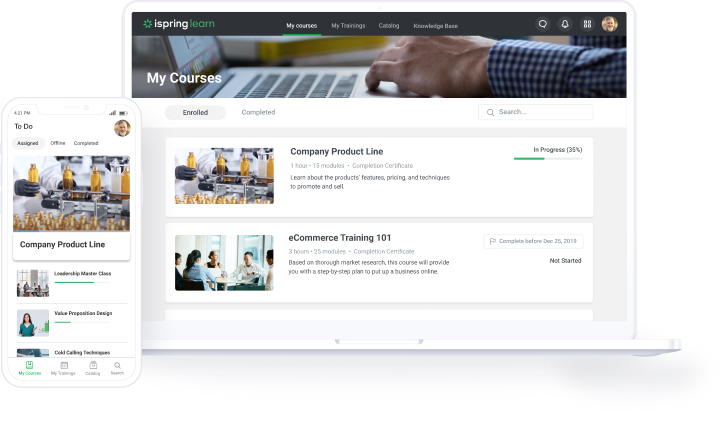
iSpring Learn is a cloud-based LMS designed for rolling out corporate training in a snap. The LMS is integrated with a powerful content authoring toolkit, allowing you to build eLearning courses to supplement VILT sessions. From role-plays to quizzes and video lectures, there is a wide variety of activities that serve to cover every training scenario. It also comes with a built-in tool for creating simple courses and quizzes online.
Since iSpring Learn has integrations with Zoom and Microsoft Teams, you can organize all of your VILT sessions from within the LMS. This creates a seamless experience for learners. VILT sessions can be added to online courses as part of a blended learning program.
With robust reporting features and strong content authoring and user management functionality, iSpring Learn is the best virtual training platform with great LMS capabilities. Moreover, the user-friendly interface and native mobile app allow users and admins to navigate it from day one with ease.
Key features
- Rich user management tools, including personalized learning tracks, self-enrollment, and customized user roles
- Simple built-in course builder and integrated powerful authoring toolkit
- Automated reporting and strong analytics, including people reports to monitor users and groups who show the greatest interest in online training
- Authentication and compliance management features, such as customizable certification
- An intuitive mobile app with offline learning capabilities
- White labeling tools to fully customize your LMS and mobile app to your brand
- Unlimited administrator roles to fit your organizational needs
iSpring Learn LMS
Automate corporate training and improve employee performance.
2. Adobe Connect

Adobe Connect is a digital learning solution that hosts high-quality virtual classrooms. It recreates the learning environment of a physical classroom and harnesses engagement tools including polls, chats, and custom apps to maintain learners’ attention. Boasting features such as custom layouts, persistent virtual rooms, templates, and collaboration tools, it’s one of the best virtual instructor-led training platforms out there.
With Adobe’s signature modern interface, Adobe Connect is fast, user-friendly, and powerful. This VILT software is perfect for hosting webinars, recording training, and running collaborative learning sessions. It also offers enhanced video and audio for a high-quality virtual experience. The real-time reporting tools allow L&D and HR teams to track all training activities effectively. Using content uploaded to the content library, instructors can build, edit, and deliver self-paced, online courses on the platform.
Key features
- Interactive features, such as polling, quizzes, presentation tools, whiteboard, and feedback collection
- Pre-meeting tools, including invitation management, scheduling, group calendars, and reminders
- Real-time reporting and analytics, including event analytics
- A range of conferencing modes: virtual meetings, internal meetings, webinars, and full HD video calls
- The ability to create curriculums (comprising courses, presentations, and meetings), define prerequisites, and assign to users
- Virtual backstage area for hosts and presenters to collaborate
- An engagement dashboard that uses digital body language and interactive participation parameters to measure participant engagement
3. TalentLMS
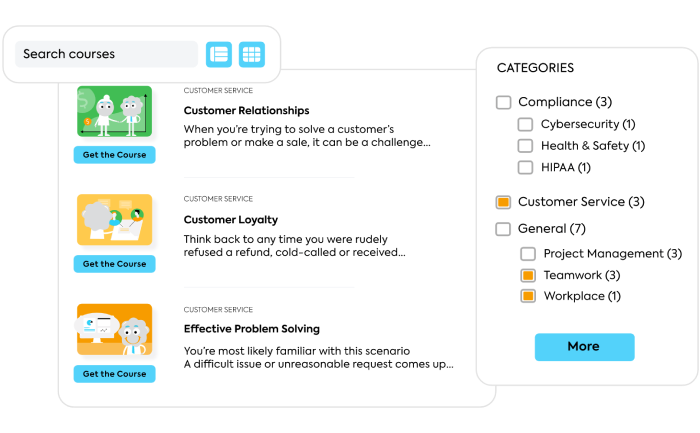
TalentLMS is a reliable platform with an impressive onboarding experience for a rapid setup. It covers all the bases, offering a range of features for social learning, gamification, and managing ILT sessions. Its branching feature allows you to create multiple sub-accounts or branches as needed. Each branch is totally customizable, with its own users, courses, and branding. This is perfect for businesses looking to train both internal and external employees. Finally, for an additional fee, you can access its library of courses created by third-party providers.
TalentLMS offers integrations with several video conferencing platforms, such as Zoom, Microsoft Teams, and GoToWebinar. This makes it a good all-around tool for businesses looking for an LMS that supports VILT sessions. Moreover, it provides a calendar to organize ILT sessions and allows live training events to be added to online courses. As such, it’s a solid virtual learning platform for rolling out a blended employee training program.
Key features
- Built-in course creator, assessment engine, and survey maker
- Report scheduling and custom reporting features, including activity logs, infographics, and a training matrix to provide an overview of your organization’s training activity
- E-commerce capabilities to sell courses, offer discounts and coupons, and integrate with PayPal and Stripe
- Communication tools, such as private messages, calendars, and discussion forums
- A talent library of ready-made, skills-based training courses
- Personalized learning paths for different audiences
- White labeling tools to fully customize the platform and mobile app
4. Docebo
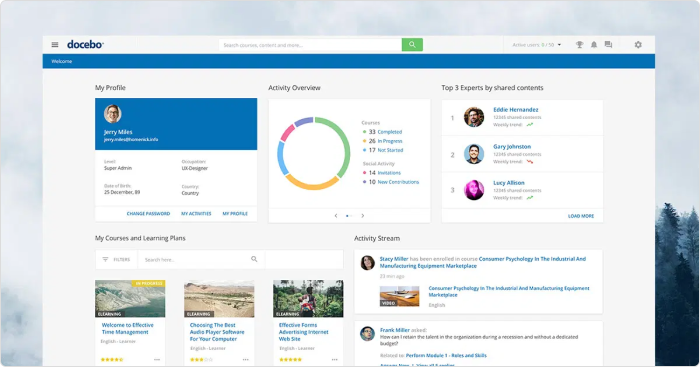
Accessible and effective, Docebo is an LMS with an excellent selection of customization features, such as personalized UI, user roles, and organization chart branches. As a result, it’s a popular learning solution for large workforces. Docebo provides innovative social learning features, a mobile app, reporting, and learning tracks to cover a wealth of training needs. In addition, for an extra fee, you can make use of its library of automated skills-based training content from a selection of external providers.
Docebo has an extensive library of over 400 integrations, including a range of webinar tools for conducting VILT sessions. These integrations include Adobe Connect, GoToMeeting, GoToWebinar, and Zoom. Thus, it’s a great option for large enterprises looking for an LMS that doubles as virtual instructor-led training software.
Key features
- Custom reporting and report scheduling
- Customizable learning paths
- AI-powered Docebo Skills provides external learning material to drive upskilling and skills-based learning
- Discover, Coach & Share – Docebo’s social learning module – allows employees to ask in-house experts questions about training content and topics from the platform
- Native LMS integration with Salesforce
- Certifications and compliance management tools
- eCommerce platform for monetizing training courses
5. Blackboard Learn + Blackboard Collaborate
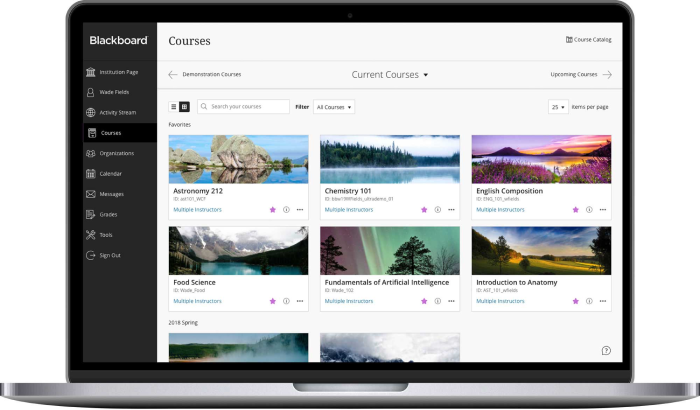
Blackboard Learn is a web-based LMS that is both reliable and powerful. A favorite in the academic field, it provides an excellent experience for both instructors and learners. While reporting and analytics may be relatively basic compared to others on this list, Blackboard Learn has some interesting learning and collaboration tools, such as real-time chat, discussions, forums, and assessments.
For an additional fee, you can integrate it with Blackboard Collaborate, a simple yet effective virtual classroom solution. Blackboard Collaborate comes with video conferencing integration and some great engagement tools such as electronic hand raising, private chat, and an interactive whiteboard. It also boasts polls, breakout groups, session recording, and on-demand webcasting to facilitate VILT sessions.
Key features
- Communication and collaboration tools such as instant messaging and Experts for directly contacting in-house experts
- An ILT calendar for scheduling classroom activities
- A feedback tool for classroom training sessions
- Reporting and report scheduling functions
- A built-in content authoring tool
- Numerous plug-ins to fill in various functionality holes
- VILT software Blackboard Collaborate can be integrated for an extra fee
6. Learn Upon
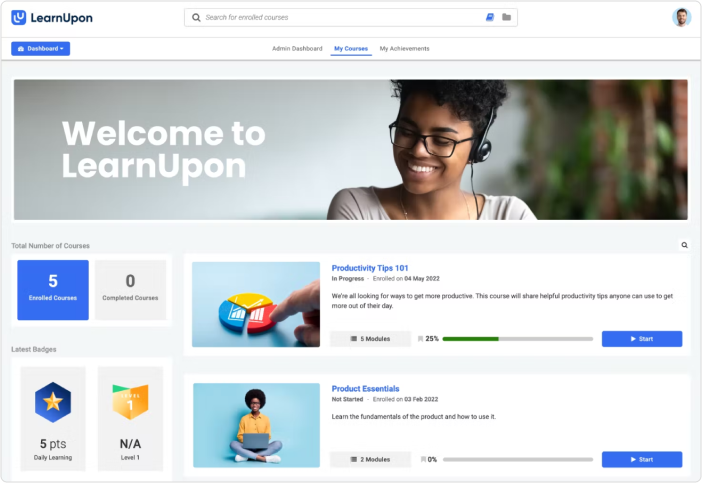
Learn Upon LMS is a cloud-based learning platform that packs a punch. It offers a broad range of features and tools to cover your training needs like comprehensive reporting features, highly customizable user management, and social learning tools. Learn Upon also comes with its own mobile learning app.
While LearnUpon is primarily an LMS, it features integrations with Zoom, Microsoft Teams, Adobe Connect, and GoToWebinar. As such, it is a great option for organizations looking for an LMS that also serves as a virtual training platform. The range of webinar tools is perfect for building blended learning programs for corporate training.
Key features
- Advanced eLearning tools, such as learning paths and social learning
- A full range of reporting options, including report scheduling and canned reports
- Compliance tools, such as certificates, deadlines, and certification expiration management
- Learning portals for creating bespoke learning environments for different learners
- Learner dashboards allowing users to track their learning progress
- Discussion forums for promoting social learning through knowledge sharing
- Customizable user roles for managers, admins, instructors, and learners
7. SAP Litmos
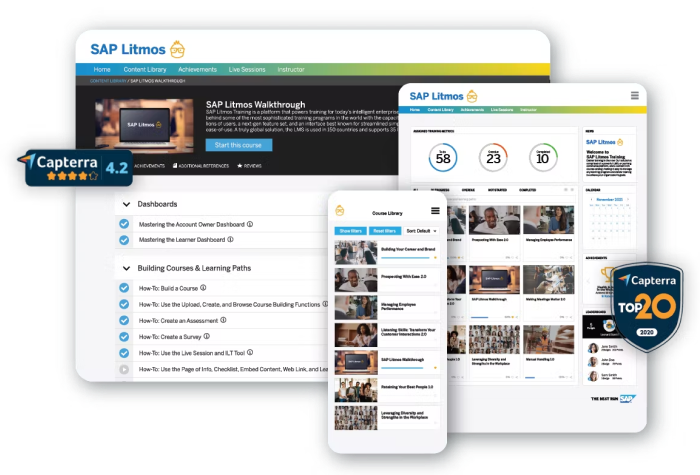
SAP Litmos is an LMS geared toward large organizations with global workforces. It comes with a range of learning features that are suited to both academic and corporate training. SAP Litmos has an impressive mobile app, an array of eCommerce integrations, customized reporting, and a built-in quiz and survey editor. Thus, it covers all major training needs. In addition, the platform offers interesting features such as noticeboards, e-signatures, and AI-powered video assessments. For an extra fee, you can access a library of off-the-shelf learning content.
SAP Litmos LMS has an extensive integration library, including GoToTraining, Microsoft Teams, Webex, and Microsoft Teams. With the ILT module, you can easily schedule virtual or classroom training sessions and provide trainees with feedback and video assessments.
Key features
- eLearning tools, including a built-in authoring tool and personalized learning paths
- White labeling to allow custom branding
- Custom, real-time reporting
- Certification and compliance management tools
- Custom UI branding and learner dashboards for multiple learner audiences
- Social learning collaboration features, such as live chat options and learner uploads
- eCommerce shopping cart and integration with Shopify to monetize courses
8. Absorb
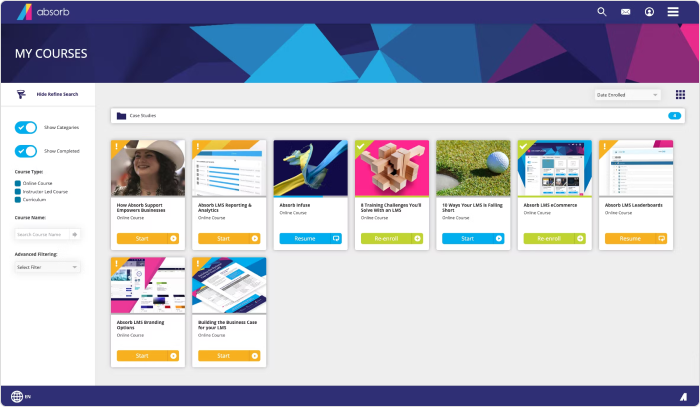
Being a cloud-based LMS designed with corporate training in mind, Absorb is one of the best virtual training platforms on the market. Its user-friendly interface and wide array of advanced features make this a powerful platform for any training scenario. Absorb comes with a built-in authoring tool, advanced customization options, and comprehensive reporting. You can also access libraries of off-the-shelf content built by third-party providers.
Absorb features a broad selection of integrations, including video conferencing tools such as Zoom and Webex. Therefore, it’s the perfect choice for large businesses looking for a state-of-the-art LMS and virtual instructor-led training tool. Absorb offers eLearning, VILT sessions, and the ability to track and manage ILT sessions, so it’s ideal for all types of learners.
Key features
- eLearning tools, including a built-in authoring tool, skill tracking, and ILT management
- Custom reporting and scheduling
- Advanced customization and branding options
- Native mobile app
- AI-driven Absorb Pinpoint feature automatically transcribes and timestamps video lessons, and makes them searchable
- LMS search analytics reporting shows what learners are searching to identify training gaps and learners’ needs
- Customizable reviewer interface for testing learners’ application of the training
9. ProProfs
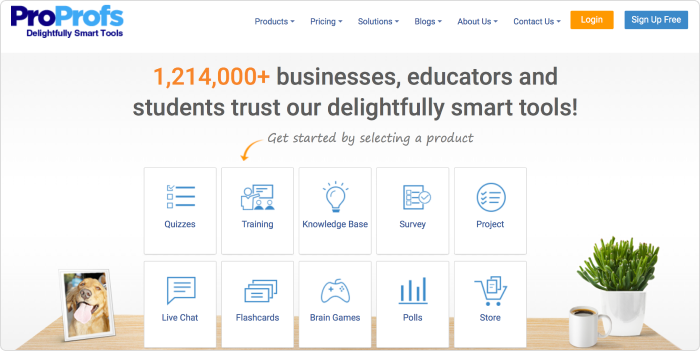
ProProfs is a cloud-based LMS with a virtual classroom, making it suitable for a range of training formats. A relatively new kid on the block, it’s easy to use and quick to set up. In addition to basic LMS capabilities, such as reporting, certification, and shared folders, it has its own course builder. You can also access a library of professionally designed online courses and customize them to suit your training needs. Besides, the platform has an impressive range of testing and assessment tools, including timed quizzes and video feedback.
ProProfs Training Maker boasts a range of features for VILT. For instance, a virtual classroom with built-in assessment tools, ILT & Webinar Tracking, and Zoom integration. Instructors can create a knowledge base within virtual classrooms so employees can access vital training content at any time.
Key features
- eLearning tools, including a built-in authoring tool, quiz maker, and learning paths
- Virtual classroom with assessment tools
- Reporting and webinar tracking
- Library of off-the-shelf training courses and customizable templates
- Native mobile app
- eCommerce platform to sell your courses, tests, and quizzes
- Feature for creating your own knowledge bases and training manuals
10. Canvas
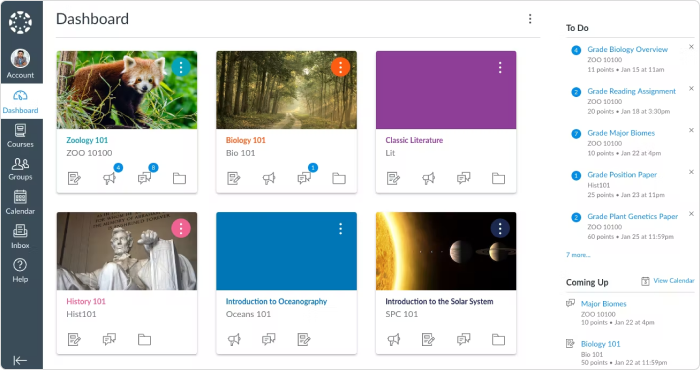
Canvas is one of the longest-standing and most well-respected platforms in the world. It’s an instructor-centric LMS that was originally designed to recreate a classroom setting. As such, it comes with some interesting school applications and a community of instructors. However, it can be adapted for a corporate training setting since it has basic reporting, gamification, social learning features, and a built-in authoring tool.
Canvas has a comprehensive library of integrations, including video conferencing tools such as BigBlueButton, Zoom, and Microsoft Teams. Furthermore, the Calendar feature makes it easy for instructors to manage classroom or VILT activities. Despite lacking some more advanced features for corporate training like customizable user roles and certification, Canvas is a solid LMS and virtual training platform.
Key features
- Built-in authoring tool and quiz maker
- Canvas studio tool for creating interactive videos
- Reporting and attendance tracking
- Mobile learning app
- A wide community of instructors
- Range of user roles options, including admin, instructor, instructional designer, observer/parent, and student
- Canvas Catalog allows you to build customized course catalogs and sub-catalogs for different learner audiences
How We Tested and Compared These Virtual Training Platforms
During the testing process, the two primary criteria we used in our comparison were:
- How it functions as a VILT platform – the features it offers for conducting online training sessions
- How it performs as an LMS – the features it offers for creating, delivering, and tracking training activities
Based on our findings, the 10 online virtual training platforms listed above are our top all-around performers.
FAQ
We’ve answered the most commonly-asked questions about virtual training and VILT platforms.
1. What is virtual training?
Virtual Instructor-led training (VILT) is when an instructor leads an online training session via a virtual learning platform or software. While the training is carried out remotely, it’s similar to conventional instructor-led training (ILT) in that it happens in real time. As such, it’s a synchronous training approach. In short, VILT follows the same interactive format as ILT classroom training, but is carried out via a virtual platform such as Zoom or Microsoft Teams.
VILT can be conducted in a number of ways and for a range of audience sizes. From 1 to 1 sessions to webinars to large virtual lectures, it’s a flexible training method that suits both large and small organizations. VILT is often combined with other training approaches, such as eLearning or face-to-face (F2F) classes as part of a blended learning program.
2. What are the benefits of virtual training?
Virtual training is a convenient and effective training solution. Learners have greater flexibility regarding when and where they train, while still having the support of an instructor. In addition, virtual training is more cost-effective for organizations and offers a greener alternative to in-person employee training and development. Finally, VILT promotes diversity by making training more accessible. In turn, more employees can take part in training sessions at the same time.
3. What key tools are needed for VILT?
To successfully carry out VILT sessions in your organization, you’ll need a couple of tools or software.
- A reliable video conferencing platform, such as Zoom, Microsoft Teams, or Google Meet. Ideally, this tool should integrate seamlessly with your LMS to streamline the training management process. This way, learners will conduct all training sessions via the LMS.
- A robust Learning Management System (LMS). An LMS allows you to design eLearning modules, build learning tracks, and automate training management tasks in one place. It also enables you to extract custom reports to track training activities.
- While not essential, an interactive whiteboard tool, such as Miro, Google Jamboard, or Mural, is a valuable VILT training tool. Using an interactive whiteboard, you can drive collaboration, annotate content, and share ideas during training sessions.
4. What are some best practices when conducting virtual training sessions?
To boost interactivity and keep learners engaged, we recommend the following best practices:
- Encourage all trainees (and the instructor) to have their webcams on
- Break up long sessions to avoid learner burnout
- Foster participation with interactive activities such as polls, breakout rooms, and quizzes
- Prepare your VILT software in advance to avoid delays or technical hiccups
Bear in mind that learners tend to get fatigued more quickly during online sessions. As such, avoid turning your workshop into a presentation by implementing a wide variety of activities that encourage learners to participate in the training.
Conclusion
Virtual learning combines the best of both worlds, offering your employees the flexibility to attend training from any location with the interactive learning experience of a classroom setting. Plus, VILT sessions can be incorporated with eLearning and face-to-face sessions seamlessly to build an effective blended learning program.
If you’re looking for a virtual training platform with robust LMS capabilities, why not start a free 14-day trial of iSpring Learn today? You can explore its full range of features for a full two weeks.
